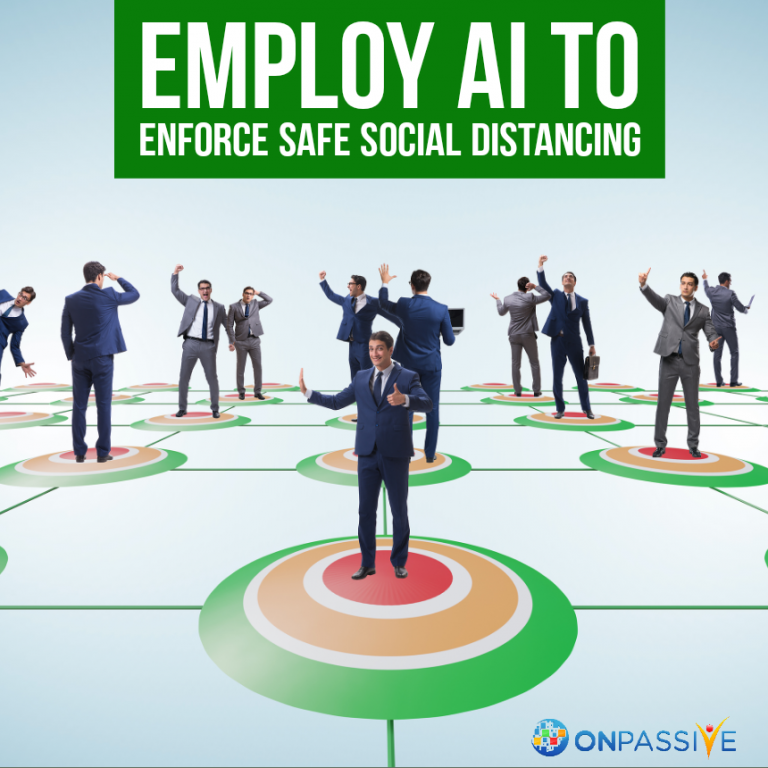
From its outbreak in China, the novel coronavirus has immensely spread to infect millions of people and has caused hundreds of deaths in at least 160 countries. From a world health point of view, it’s deeply concerning; the spread has gone out of control, and we should prepare ourselves to face the reality that it will affect everyone in some way.
During the times of the outbreak of a deadly virus, quickly identifying a vaccine is crucial to saving lives, and this is where AI comes in. The fight against the COVID-19 backed by another life-saving technology – Artificial Intelligence. As the pandemic is pacing to its next phase and businesses, plan to reopen around the globe. Companies are rethinking the layouts of their offices and other operational processes to ensure safe working conditions met amid the health crisis.
AI to maintain Social Distance Standards:
The only weapon used against the COVID-19 outbreak is social distancing and quarantining those exposed to the virus. Contemporary medical practices like instant temperature checks, facial masks, hand sanitizers, hand gloves, and other social distancing norms are mandatory for everyone in public or even to those at home. These social distancing methods are proven very effective in keeping the virus at bay.
These norms are the same in the workplace, and businesses are also turning to new technologies to respond to the crisis that has occurred on them. One of the AI subfields called NLP (Natural language processing systems) is helping in contact centers, on various websites and in the workflow, including process automation.
Businesses use image systems for a range of areas, including hands-free identity systems, remote inspection, track-and-trace systems, and temperature checking, and guiding physical workplaces to implement social distancing. Let us see more such practices being implemented with the help of artificial intelligence:
Dynamic Tracking
With the help of AI systems, the virus management team is dynamically tracing the epidemic information from various sources. Various groups from across the world utilize AI to complete the statistics from distinct sources and for epidemic indicators. Image systems are helping the response team to track and observe the infected at home in real-time. In this way, it is easy to tackle and evaluate the government and the medical community’s efforts in deploying preventions and control measures in the times of an on-going emergency.
Automated Monitoring of Social Distancing in Public
In times of an epidemic like COVID-19, surveillance is crucial. Human activity in public, especially in workplaces and migration between physical places, has been responsible for the worldwide spread of the virus. Many organizations are using machine learning and NLP systems to track, recognize, and report the virus’s spread. These AI systems help various medical teams worldwide tackle the challenges of monitoring the spread of the virus to millions and save it before it becomes uncontrollable.
Artificial Intelligence in the Workplace Surveillance
Amazon has built a monitoring AI system called – Distance Assistance. This software designed to monitor the distances between their staff in the warehouse and workplace. Amazon is planning on making it an open-source platform to make it readily available to the growing suite of technologies to survey their workers. Landing AI’s social distance detector systems can flag up warnings in real-time when there are changes in the behaviors on a certain standard. The coronavirus pandemic has waked up this trend.
Virtual Healthcare Assistants
The accelerating number of COVID-19 cases has shown that healthcare systems and prevention measures can be overwhelmed. A Canada based AI company is using its natural language processing capabilities to help the healthcare websites in building a multi-lingual virtual healthcare assistant that can answer questions related to coronavirus, provide reliable information and transparent regulations, recommend prevention measures, track and monitor symptoms, and advise the users whether they need professional medical screening or self-isolation at their homes.
Diagnostic AI
AI immensely helps in stopping the massive outspread of infection by monitoring the quarantine measures. AI is helping healthcare systems with improved diagnostic time through intelligent technology. Pneumonia can now be diagnosed from an analysis of a CT scan in a minute with 92% accuracy and a recall rate of 97% on coronavirus test data sets. This achieved by an open-source AI model that boosted the analysis of CT images. It was easy to identify the lesions and quantifying them in terms of number, volume, and proportion. A Beijing-based built this platform during the outbreak in China.
After years of discoveries and some superficial uses, now could be the right time for AI to prove its worth, as it deployed in many helpful ways to keep humanity safe amid the pandemic. But what AI in Social distancing systems show is that we’re at the beginning of a wave of innovation that will transform industries and workplaces, followed in the next wake of the coronavirus or any such similar outbreaks.



Stemler János
4 years ago